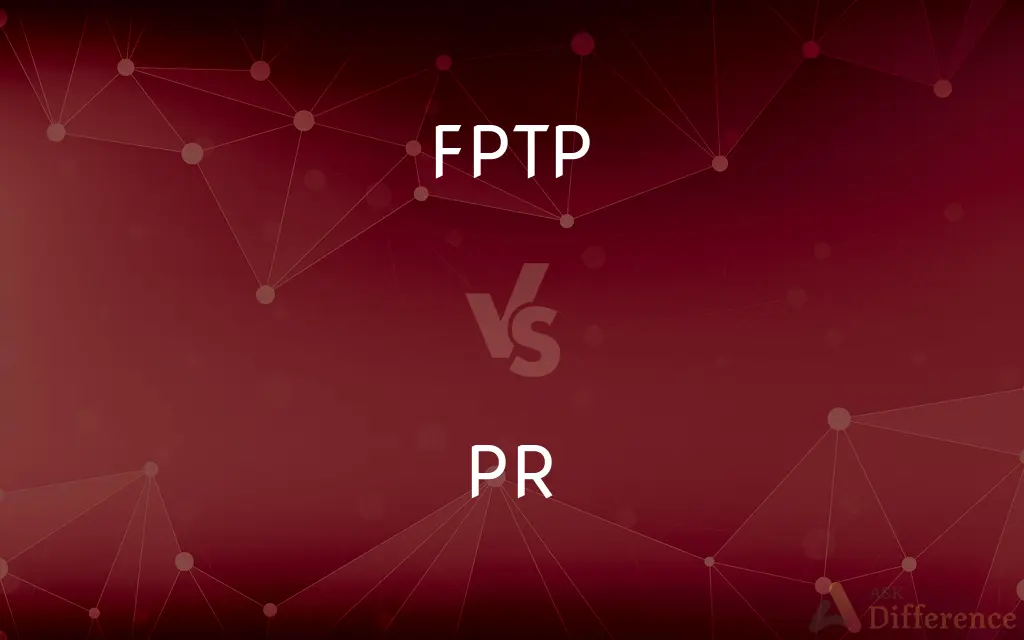FPTP vs. PR — What's the Difference?
By Tayyaba Rehman — Published on December 22, 2023
FPTP (First Past The Post) awards the candidate with the most votes in a district, while PR (Proportional Representation) allocates seats based on the proportion of votes each party receives.

Difference Between FPTP and PR
Table of Contents
ADVERTISEMENT
Key Differences
FPTP and PR are both electoral systems, but they function on fundamentally different principles.
FPTP, standing for First Past The Post, operates on a winner-takes-all basis. In this system, the candidate with the most votes in a particular district or constituency wins. Conversely, PR, which means Proportional Representation, ensures that parties gain seats in proportion to the number of votes cast for them.
In FPTP, minor parties often find it hard to secure representation, even if they have significant support across the entire electorate. On the other hand, PR typically allows for a broader representation of parties, making it more inclusive.
While FPTP often results in stable majority governments, due to its nature of favoring dominant parties, PR can lead to coalition governments as it's more likely for multiple parties to secure seats.
In summary, while FPTP is straightforward and can lead to decisive results, PR ensures a more representative outcome, capturing the diverse political sentiments of the electorate.
ADVERTISEMENT
Comparison Chart
System Basis
Winner-takes-all
Seats allocated based on vote proportion
Representation of Minor Parties
Often underrepresented
More inclusive, allowing for broader representation
Government Outcome
Typically results in stable majority governments
Often leads to coalition governments
Voter Strategy
Can lead to tactical voting as voters may vote against the least desired rather than for preferred
Encourages genuine preferences as every vote can influence the overall seat count
Geographic Representation
Candidates represent specific districts/constituencies
Parties often represent larger regions or entire nations
Compare with Definitions
FPTP
A straightforward electoral system often leading to majority governments.
Thanks to FPTP, the leading party secured a decisive victory.
PR
An electoral system that allocates seats based on vote proportion.
Many European countries use PR to ensure diverse political representation.
FPTP
Direct representation based on district or constituency.
With FPTP, each district elects its own representative based on majority votes.
PR
Ensures broader political representation.
PR allows even smaller parties to gain seats, reflecting varied voter preferences.
FPTP
Can lead to underrepresentation of minor parties.
Critics argue that FPTP leaves several voices unheard in the political arena.
PR
Encourages voters to express their genuine preferences.
Under PR, there's less need for tactical voting, ensuring genuine electoral outcomes.
FPTP
Winner-takes-all voting method.
Many believe FPTP can sometimes fail to represent the broader public sentiment.
PR
Can lead to coalition governments due to diverse seat allocations.
The use of PR in the elections resulted in a coalition between three parties.
FPTP
An electoral system where the candidate with the most votes wins.
In the recent election, the winner was determined by FPTP.
PR
Often represents larger regions or entire nations.
PR systems usually focus on broader areas rather than specific constituencies.
PR
A soft yellowish-white trivalent metallic element of the rare earth group; can be recovered from bastnasite or monazite by an ion-exchange process
PR
A self-governing commonwealth associated with the United States occupying the island of Puerto Rico
PR
A promotion intended to create goodwill for a person or institution
Common Curiosities
What type of government does FPTP usually result in?
FPTP typically results in stable majority governments.
Are coalition governments more common under PR?
Yes, PR often leads to coalition governments due to diverse party representation.
Which system encourages voters to vote their true preference?
PR encourages genuine voter preferences as every vote can influence the seat count.
How does FPTP determine election winners?
In FPTP, the candidate with the majority of votes in a district or constituency wins.
How does PR allocate seats to parties?
PR allocates seats based on the proportion of votes each party receives.
Is FPTP used more in the USA or the UK?
Both the USA and the UK primarily use FPTP for their major elections.
Which system is seen as more straightforward?
FPTP is often seen as more straightforward due to its winner-takes-all nature.
What do FPTP and PR stand for?
FPTP stands for First Past The Post and PR stands for Proportional Representation.
Which system is more likely to represent minor parties?
PR is more inclusive and likely to represent minor parties.
Can FPTP lead to tactical voting?
Yes, voters might vote against their least preferred candidate rather than for their favorite under FPTP.
Does PR always lead to a fragmented political landscape?
Not always, but PR often results in a diverse range of parties gaining representation.
How do regions or constituencies differ under FPTP and PR?
In FPTP, candidates represent specific districts, while PR often represents larger regions.
Which system is more likely to give a conclusive result in a single round of voting?
FPTP is more likely to produce a decisive outcome in a single voting round.
Why might some countries prefer PR over FPTP?
Some countries prefer PR for its inclusive nature, ensuring broader political representation.
Can a country use both FPTP and PR in different elections?
Yes, some countries use FPTP for certain elections and PR for others, mixing representation methods.
Share Your Discovery

Previous Comparison
Magnesium vs. Magnesium Oxide
Next Comparison
Heavy Cream vs. Evaporated MilkAuthor Spotlight
Written by
Tayyaba RehmanTayyaba Rehman is a distinguished writer, currently serving as a primary contributor to askdifference.com. As a researcher in semantics and etymology, Tayyaba's passion for the complexity of languages and their distinctions has found a perfect home on the platform. Tayyaba delves into the intricacies of language, distinguishing between commonly confused words and phrases, thereby providing clarity for readers worldwide.
















































